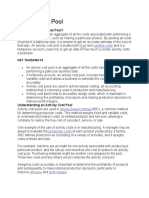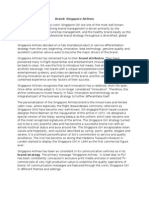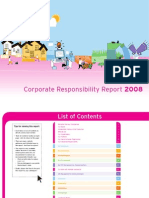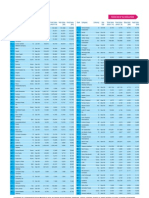0 ratings0% found this document useful (0 votes)
37 viewsActivity Based Costing
Activity Based Costing
Uploaded by
Allysa NavarroActivity based costing (ABC) is an approach that assigns manufacturing overhead costs to products in a more accurate way than traditional costing methods. ABC first assigns overhead costs to the specific activities that cause those costs, like machine setups or engineering. It then only allocates the costs of each activity to the products that demanded that particular activity. This leads to more precise allocation of overhead costs than simple methods like allocating all overhead based on machine hours. ABC may involve a two-stage cost allocation process where overhead is first assigned to intermediate cost pools and then allocated from those pools to final products using multiple cost drivers. A key assumption of ABC is that overhead costs are caused by different activities that products utilize in varying amounts.
Copyright:
© All Rights Reserved
Available Formats
Download as DOCX, PDF, TXT or read online from Scribd
Activity Based Costing
Activity Based Costing
Uploaded by
Allysa Navarro0 ratings0% found this document useful (0 votes)
37 views2 pagesActivity based costing (ABC) is an approach that assigns manufacturing overhead costs to products in a more accurate way than traditional costing methods. ABC first assigns overhead costs to the specific activities that cause those costs, like machine setups or engineering. It then only allocates the costs of each activity to the products that demanded that particular activity. This leads to more precise allocation of overhead costs than simple methods like allocating all overhead based on machine hours. ABC may involve a two-stage cost allocation process where overhead is first assigned to intermediate cost pools and then allocated from those pools to final products using multiple cost drivers. A key assumption of ABC is that overhead costs are caused by different activities that products utilize in varying amounts.
Original Description:
Managerial Accounting
Copyright
© © All Rights Reserved
Available Formats
DOCX, PDF, TXT or read online from Scribd
Share this document
Did you find this document useful?
Is this content inappropriate?
Activity based costing (ABC) is an approach that assigns manufacturing overhead costs to products in a more accurate way than traditional costing methods. ABC first assigns overhead costs to the specific activities that cause those costs, like machine setups or engineering. It then only allocates the costs of each activity to the products that demanded that particular activity. This leads to more precise allocation of overhead costs than simple methods like allocating all overhead based on machine hours. ABC may involve a two-stage cost allocation process where overhead is first assigned to intermediate cost pools and then allocated from those pools to final products using multiple cost drivers. A key assumption of ABC is that overhead costs are caused by different activities that products utilize in varying amounts.
Copyright:
© All Rights Reserved
Available Formats
Download as DOCX, PDF, TXT or read online from Scribd
Download as docx, pdf, or txt
0 ratings0% found this document useful (0 votes)
37 views2 pagesActivity Based Costing
Activity Based Costing
Uploaded by
Allysa NavarroActivity based costing (ABC) is an approach that assigns manufacturing overhead costs to products in a more accurate way than traditional costing methods. ABC first assigns overhead costs to the specific activities that cause those costs, like machine setups or engineering. It then only allocates the costs of each activity to the products that demanded that particular activity. This leads to more precise allocation of overhead costs than simple methods like allocating all overhead based on machine hours. ABC may involve a two-stage cost allocation process where overhead is first assigned to intermediate cost pools and then allocated from those pools to final products using multiple cost drivers. A key assumption of ABC is that overhead costs are caused by different activities that products utilize in varying amounts.
Copyright:
© All Rights Reserved
Available Formats
Download as DOCX, PDF, TXT or read online from Scribd
Download as docx, pdf, or txt
You are on page 1of 2
Activity Based Costing
Activity based costing (ABC) assigns manufacturing overhead costs to products in a
more logical manner than the traditional approach of simply allocating costs on the
basis of machine hours. Activity based costing first assigns costs to the activities
that are the real cause of the overhead. It then assigns the cost of those activities
only to the products that are actually demanding the activities. Activity based
costing recognizes that the special engineering, special testing, machine setups,
and others are activities that cause coststhey cause the company to consume
resources. Under ABC, the company will calculate the cost of the resources used in
each of these activities. Next, the cost of each of these activities will be assigned
only to the products that demanded the activities.
Activity-based costing (ABC) is a better, more accurate way of allocating
overhead.
Recall the steps to product costing:
1.
2.
3.
4.
Identify the cost object;
Identify the direct costs associated with the cost object;
Identify overhead costs;
Select the cost allocation base for assigning overhead costs to the cost
object;
5. Develop the overhead rate per unit for allocating overhead to the cost
object.
Activity-based costing refines steps #3 and #4 by dividing large heterogeneous cost
pools into multiple smaller, homogeneous cost pools. ABC then attempts to select,
as the cost allocation base for each overhead cost pool, a cost driver that best
captures the cause and effect relationship between the cost object and the
incurrence of overhead costs. Often, the best cost driver is a nonfinancial variable.
ABC can become quite elaborate. For example, it is often beneficial to employ a
two-stage allocation process whereby overhead costs are allocated to intermediate
cost pools in the first stage, and then allocated from these intermediate cost pools
to products in the second stage. Why is this intermediate step useful? Because it
allows the introduction of multiple cost drivers for a single overhead cost item.
This two-stage allocation process is illustrated in the example of the apparel factory
below.
ABC focuses on activities. A key assumption in activity-based costing is that
overhead costs are caused by a variety of activities, and that different products
utilize these activities in a non-homogeneous fashion. Usually, costing the activity is
an intermediate step in the allocation of overhead costs to products, in order to
obtain more accurate product cost information. Sometimes, however, the activity
itself is the cost object of interest. For example, managers at Levi Strauss & Co.
might want to know how much the company spends to acquire denim fabric, as
input in a sourcing decision. The activity of acquiring fabric incurs costs
associated with negotiating prices with suppliers, issuing purchase orders, receiving
fabric, inspecting fabric, and processing payments and returns.
You might also like
- ABC CostigDocument29 pagesABC CostigRkenterprise100% (1)
- SM ToyotaDocument40 pagesSM ToyotaSaad Kalave67% (3)
- Activity Based Costing (ABC) : Cost & Management AccountingDocument14 pagesActivity Based Costing (ABC) : Cost & Management AccountingUrooj MustafaNo ratings yet
- Class 4Document7 pagesClass 4carlaNo ratings yet
- 2024 Activity Based Costing and ManagementDocument12 pages2024 Activity Based Costing and Managementwambualucas74No ratings yet
- ABCDocument13 pagesABCSunil Bodo RaitoNo ratings yet
- Activity Based CostingDocument58 pagesActivity Based Costingvangoorihome2No ratings yet
- Part - 3 - Abc CostingDocument7 pagesPart - 3 - Abc CostingDaniel BalchaNo ratings yet
- Activity Based CostingDocument51 pagesActivity Based Costingvenkatkamineni01No ratings yet
- Chapter 5 NotesDocument6 pagesChapter 5 NotesXenia MusteataNo ratings yet
- The Strategic Role of Activity-Based CostingDocument2 pagesThe Strategic Role of Activity-Based CostingDabelisthaNo ratings yet
- Unit - 9 Modern Methods of Management AccountingDocument18 pagesUnit - 9 Modern Methods of Management AccountingAayushi KothariNo ratings yet
- Activity Based Costing NotesDocument3 pagesActivity Based Costing NotesBoipelo ThatoNo ratings yet
- ABC TheoryDocument51 pagesABC TheoryJahanzaib Butt100% (1)
- Activity Based CostingDocument24 pagesActivity Based Costingmehnaz kNo ratings yet
- Activity-Based Costing (ABC)Document2 pagesActivity-Based Costing (ABC)ramniwas sharmaNo ratings yet
- Strategic Cost Accounting M. Com (Semester IV) Topic-Activity Based CostingDocument8 pagesStrategic Cost Accounting M. Com (Semester IV) Topic-Activity Based CostingDarshi PancholiNo ratings yet
- Activity Cost PoolDocument2 pagesActivity Cost PoolNiño Rey LopezNo ratings yet
- Chapter VI Lecture NoteDocument14 pagesChapter VI Lecture NotegereNo ratings yet
- Abc Report ScriptDocument2 pagesAbc Report ScriptKim DedicatoriaNo ratings yet
- Part - 3 - ABC CostingDocument14 pagesPart - 3 - ABC CostingDaniel BalchaNo ratings yet
- Costing Assignment 1 Report 2020Document7 pagesCosting Assignment 1 Report 2020rachel 1564No ratings yet
- Chapter Three PDFDocument33 pagesChapter Three PDFSum AïyahNo ratings yet
- Activity Based CostingDocument7 pagesActivity Based Costingabiodun olatunbosunNo ratings yet
- Cma CH 3 - Abc March 2019-1Document43 pagesCma CH 3 - Abc March 2019-1Henok FikaduNo ratings yet
- Chapter Five Lecture NoteDocument15 pagesChapter Five Lecture NoteAbrha636No ratings yet
- Unit 5 ABC - TheoryDocument9 pagesUnit 5 ABC - Theoryzidanehossain54No ratings yet
- Traditional Costing Systems and ActivityDocument8 pagesTraditional Costing Systems and ActivityMisganaw MekonnenNo ratings yet
- Chapter 5 Activity Based Costing - DO-unlockedDocument49 pagesChapter 5 Activity Based Costing - DO-unlockedtirupati phutelaNo ratings yet
- Activity Based Costing Lecture NotesDocument5 pagesActivity Based Costing Lecture NotesskizajNo ratings yet
- Costing Textbook CADocument294 pagesCosting Textbook CAAryan RajNo ratings yet
- ABC Costing (1) CostDocument17 pagesABC Costing (1) CostMuhammad BilalNo ratings yet
- Fifth Unit - Activity Based CostingDocument9 pagesFifth Unit - Activity Based Costingrajesh337masssNo ratings yet
- Activity Based CostingDocument24 pagesActivity Based CostingShaikh SuhailNo ratings yet
- TempDocument28 pagesTempKIMBERLY MUKAMBANo ratings yet
- Activity Based CostingDocument10 pagesActivity Based CostingMohd SajidNo ratings yet
- Advance Cost MGMT Chapter TwoDocument43 pagesAdvance Cost MGMT Chapter TwoMame AbrarNo ratings yet
- ABC CostingDocument10 pagesABC CostingJerilyn EscañoNo ratings yet
- Activity Based Cosing Assignment PDFDocument73 pagesActivity Based Cosing Assignment PDFAjinkya ChincholeNo ratings yet
- What Is 'Activity-Based Costing (ABC) 'Document2 pagesWhat Is 'Activity-Based Costing (ABC) 'komal komalNo ratings yet
- Activity Based Coting ExamplesDocument14 pagesActivity Based Coting ExamplesMuhammad azeem100% (1)
- Activty Based CostingDocument27 pagesActivty Based CostingCriscel BogñalosNo ratings yet
- AccountingDocument20 pagesAccountingAbdul AyoubNo ratings yet
- Activity Based CostingDocument9 pagesActivity Based CostingAmitNo ratings yet
- ABC ShortDocument3 pagesABC Shortsunil.ctNo ratings yet
- Abc Costing.Document31 pagesAbc Costing.shahidulislamtaluckderNo ratings yet
- Activity Based CostingDocument2 pagesActivity Based CostingVictor StefanoNo ratings yet
- Activity Based CostingDocument3 pagesActivity Based CostingDr Linda Mary SimonNo ratings yet
- Activity Based CostingDocument3 pagesActivity Based CostingDr Linda Mary SimonNo ratings yet
- Activity-Based Costing (ABC)Document4 pagesActivity-Based Costing (ABC)Dach GamersNo ratings yet
- Financial Decision Making (FINM036) (University of Northampton-MBA) Lecturer: Arvind Harris Aharris@mauritius - Amity.eduDocument6 pagesFinancial Decision Making (FINM036) (University of Northampton-MBA) Lecturer: Arvind Harris Aharris@mauritius - Amity.eduMelvinNo ratings yet
- Cost M PDFDocument30 pagesCost M PDFabel habtamuNo ratings yet
- Document (9) Assignment 2Document5 pagesDocument (9) Assignment 2Abdul JabbarNo ratings yet
- Presented byDocument10 pagesPresented bydeviaayNo ratings yet
- Activity Based CostingDocument31 pagesActivity Based Costingwww.nickpicsplusNo ratings yet
- Abc SummaryDocument2 pagesAbc SummaryJana RaoNo ratings yet
- ABC CostingDocument4 pagesABC CostingKathleenNo ratings yet
- Written Assignment Unit 2Document5 pagesWritten Assignment Unit 2lahiru madushanNo ratings yet
- Acitvity 05 ABCDocument6 pagesAcitvity 05 ABCeleazarmontes09No ratings yet
- 13.target Costing & Activity Based CostingDocument5 pages13.target Costing & Activity Based Costingmercatuz50% (4)
- Philip Kotler: Marketing 3.0Document5 pagesPhilip Kotler: Marketing 3.0Sherif ElkadyNo ratings yet
- A Textbook of Veterinary Systemic PathologyDocument602 pagesA Textbook of Veterinary Systemic PathologyShnSrb100% (5)
- Al Mosafer OfficeDocument2 pagesAl Mosafer OfficeTota BabaNo ratings yet
- Audit PlanDocument5 pagesAudit PlanprincessmagpatocNo ratings yet
- CMMSDocument61 pagesCMMSsamobu100% (1)
- Adms2500 Chapter 04Document130 pagesAdms2500 Chapter 04braveali999No ratings yet
- Enq HegDocument2 pagesEnq Hegsohan.meggerNo ratings yet
- Board Exam Readiness Survey: New Era UniversityDocument3 pagesBoard Exam Readiness Survey: New Era UniversityKurt Canero100% (1)
- Singapore AirlineDocument2 pagesSingapore Airlineramanuj53100% (1)
- Chap 8Document13 pagesChap 8MichelleLeeNo ratings yet
- Car Loan Agreement For CompaniesDocument51 pagesCar Loan Agreement For CompaniesMohammad Ali Reza AhmedNo ratings yet
- Perceptions of ABM StudentDocument48 pagesPerceptions of ABM StudentJulie Ann Baltazar Gonzales86% (7)
- Form 27 For Labour Department-2Document1 pageForm 27 For Labour Department-2chander kantNo ratings yet
- Luminex LTMon For Channel GatewayDocument0 pagesLuminex LTMon For Channel GatewayNome123456No ratings yet
- Ashish Nanda CVDocument20 pagesAshish Nanda CVdindoNo ratings yet
- DfgoidsnbopseiuhbpsodifhDocument2 pagesDfgoidsnbopseiuhbpsodifhAdamNo ratings yet
- BITC CR Report 08Document60 pagesBITC CR Report 08Sujani MaarasingheNo ratings yet
- Accountancy CBSE Class 11 Final Project Sample –… 4Document2 pagesAccountancy CBSE Class 11 Final Project Sample –… 4reddyrushik123No ratings yet
- Fco Export - Opjm To Sas - CP10Document4 pagesFco Export - Opjm To Sas - CP10anoman123100% (1)
- Chapter - 4.2: Stock BrokingDocument10 pagesChapter - 4.2: Stock BrokingNisarg ShahNo ratings yet
- Annual Report & Accounts 2012 Presco Plc.Document48 pagesAnnual Report & Accounts 2012 Presco Plc.Dhameloolah LawalNo ratings yet
- MTP 17 51 Questions 1710158898Document11 pagesMTP 17 51 Questions 1710158898Naveen R HegadeNo ratings yet
- National Deworming Day ProcessDocument12 pagesNational Deworming Day ProcessDp poojitha100% (1)
- Top 100 Food ComDocument1 pageTop 100 Food ComSeeni VasanNo ratings yet
- 19.22 Hyperfill-updated-GMAWDocument2 pages19.22 Hyperfill-updated-GMAWedwinNo ratings yet
- BUSSINESDocument3 pagesBUSSINESNatalia FonzoNo ratings yet
- Munna Yadav From 13 MC To ContinentalDocument2 pagesMunna Yadav From 13 MC To Continentalall online work hubNo ratings yet
- About Fashion AddictDocument9 pagesAbout Fashion Addictgdthehellboy7No ratings yet
- Saln 2020 FormDocument2 pagesSaln 2020 FormGenesis ManiacopNo ratings yet

























































































